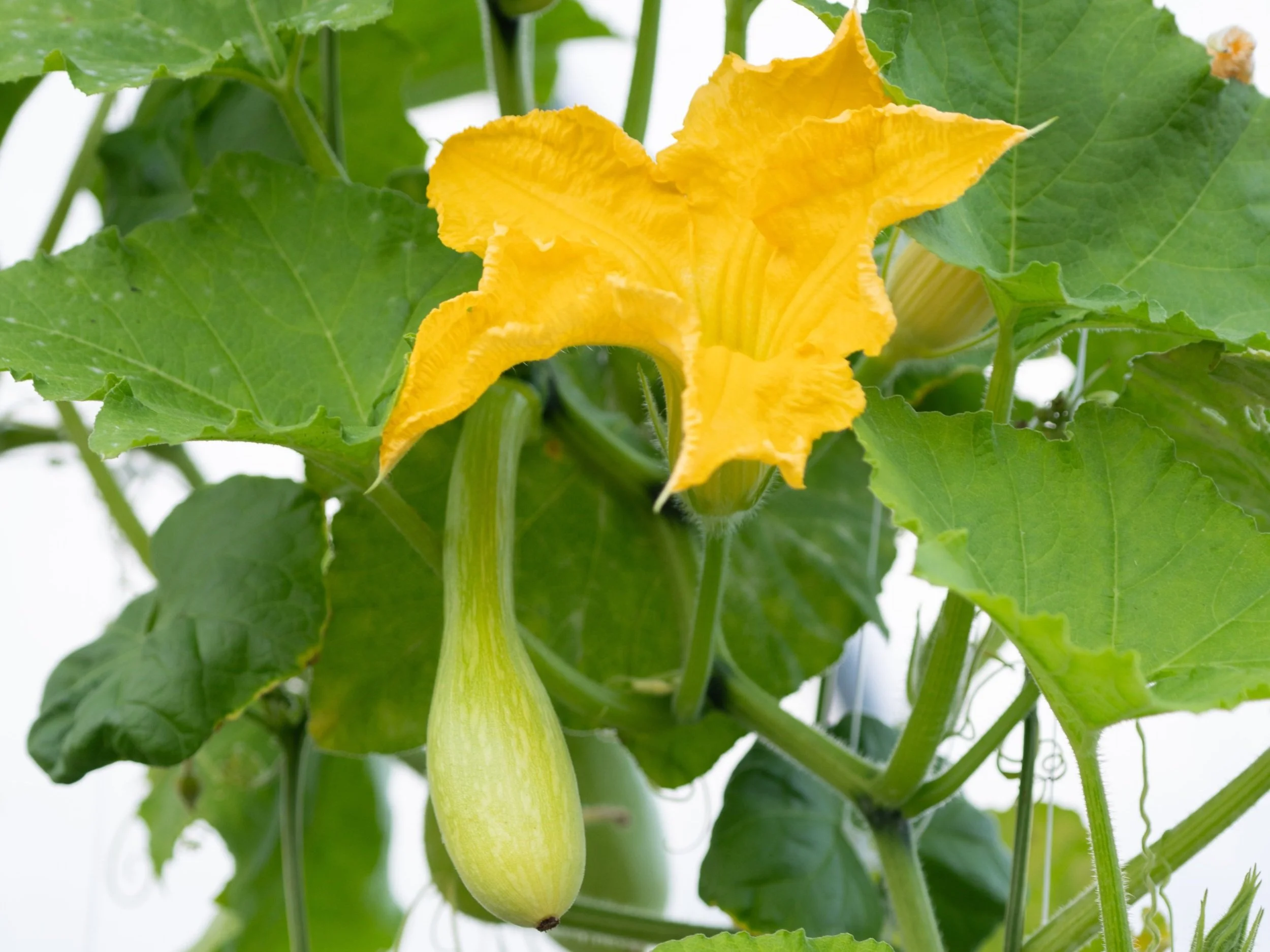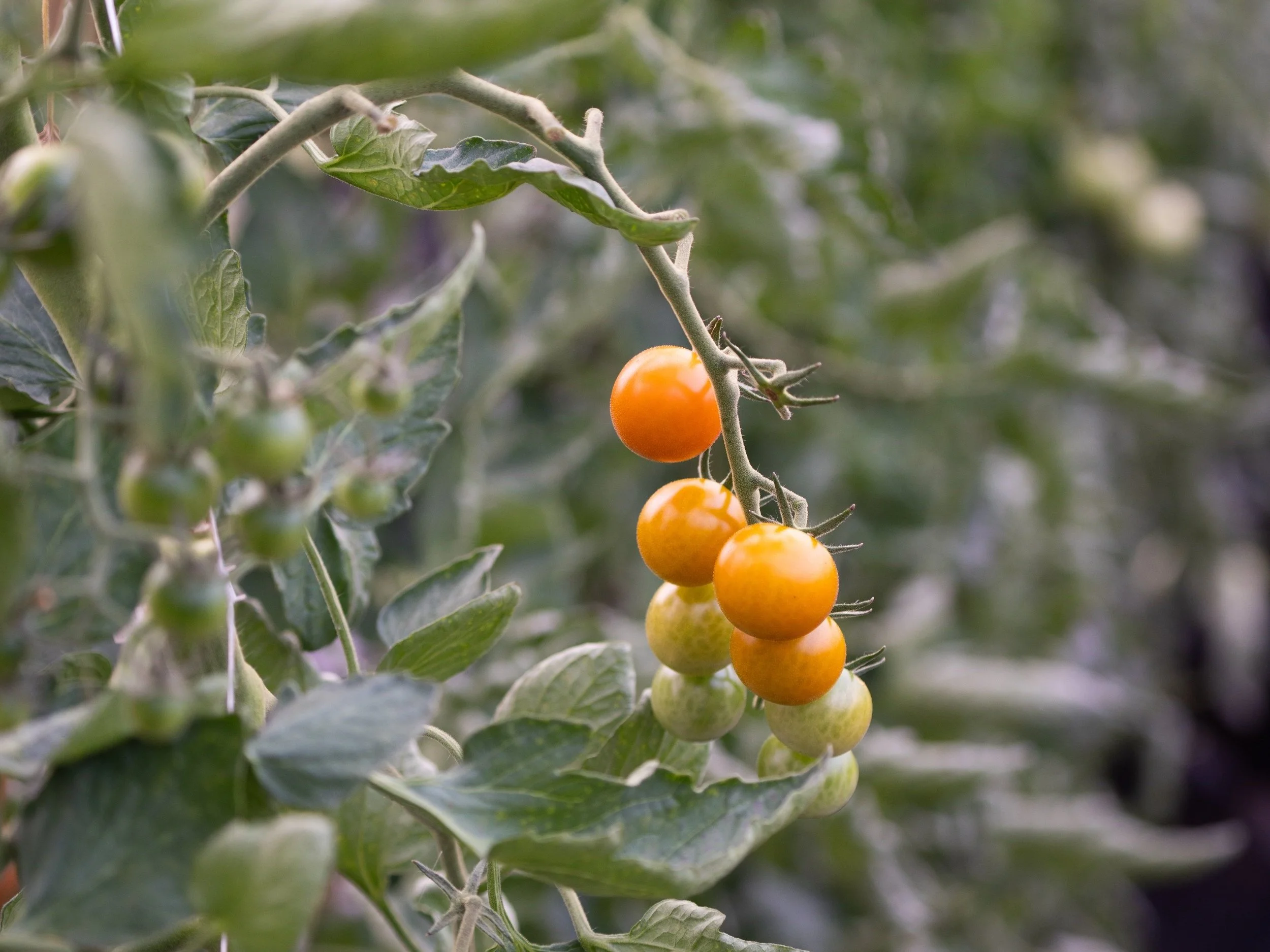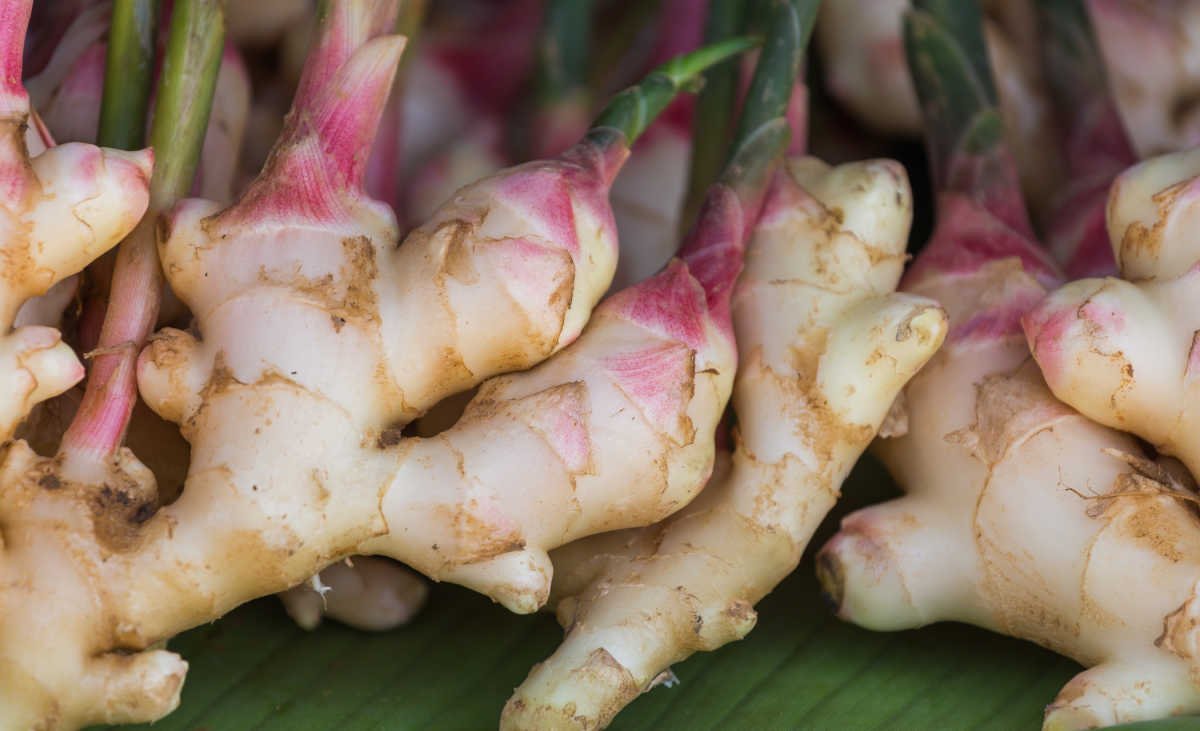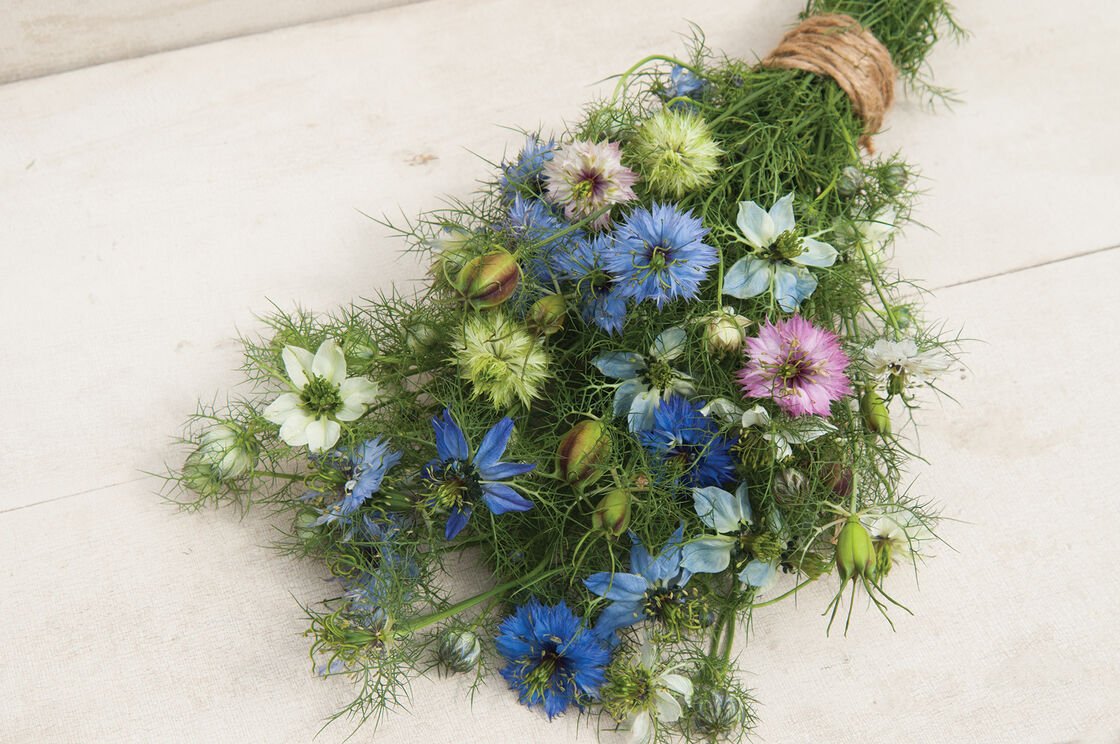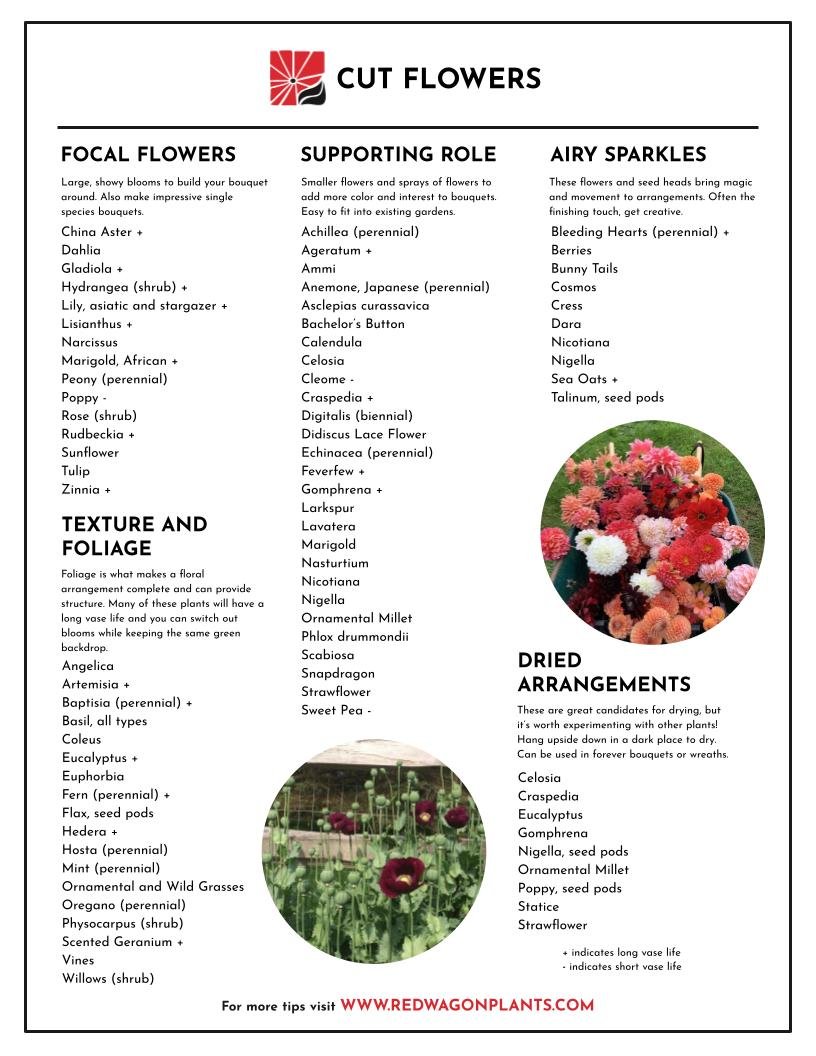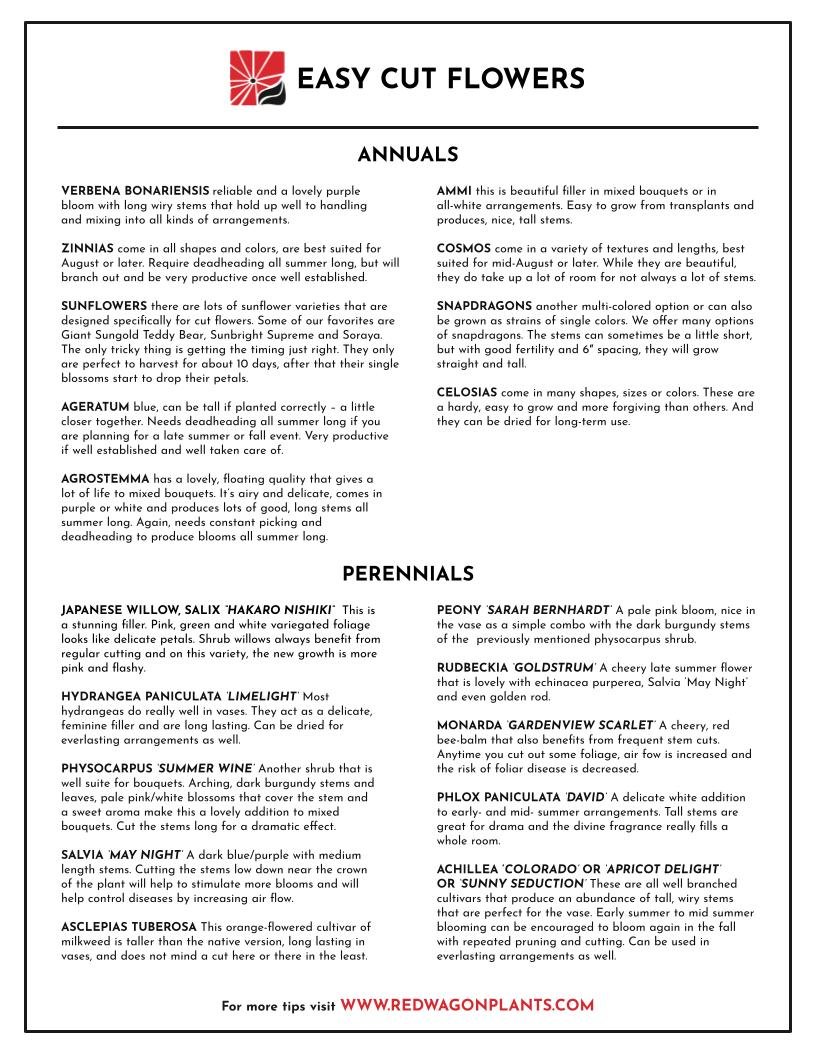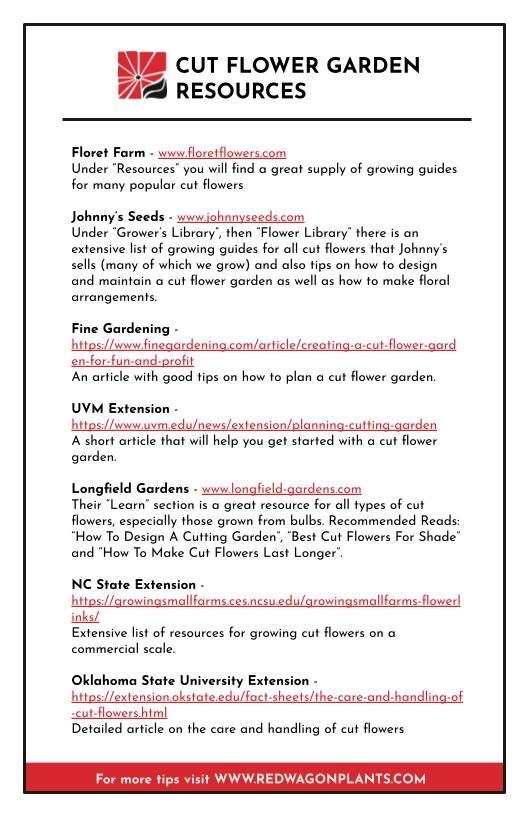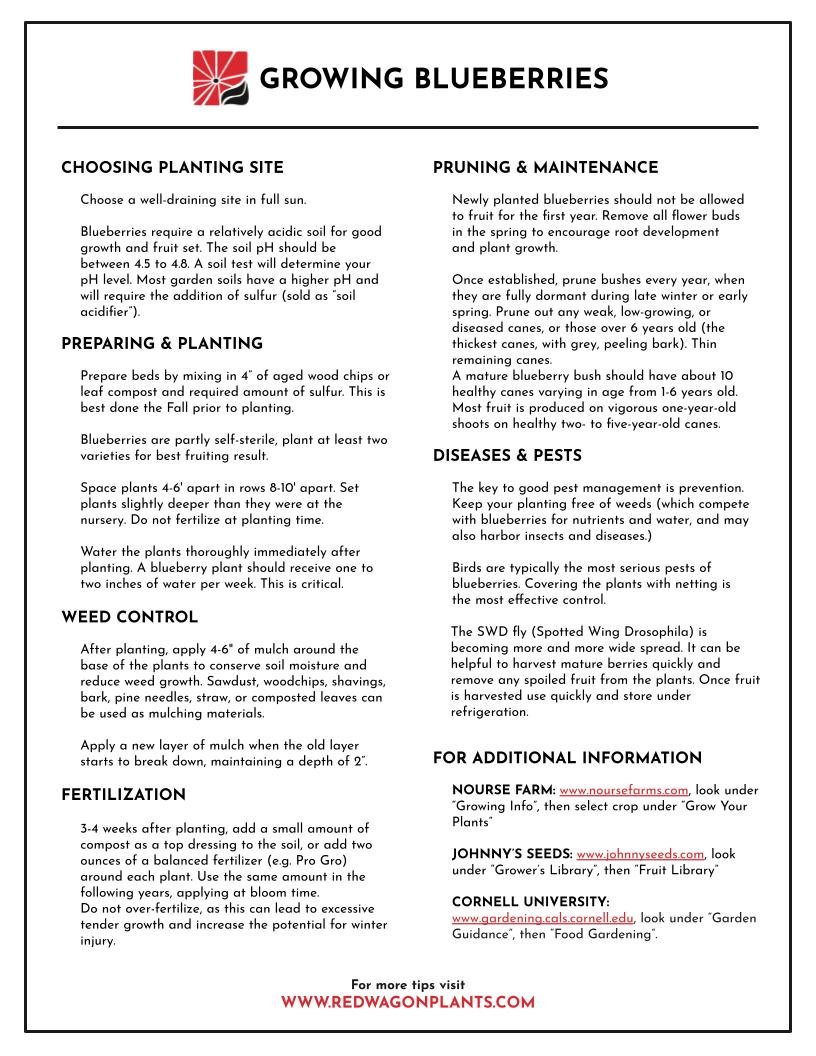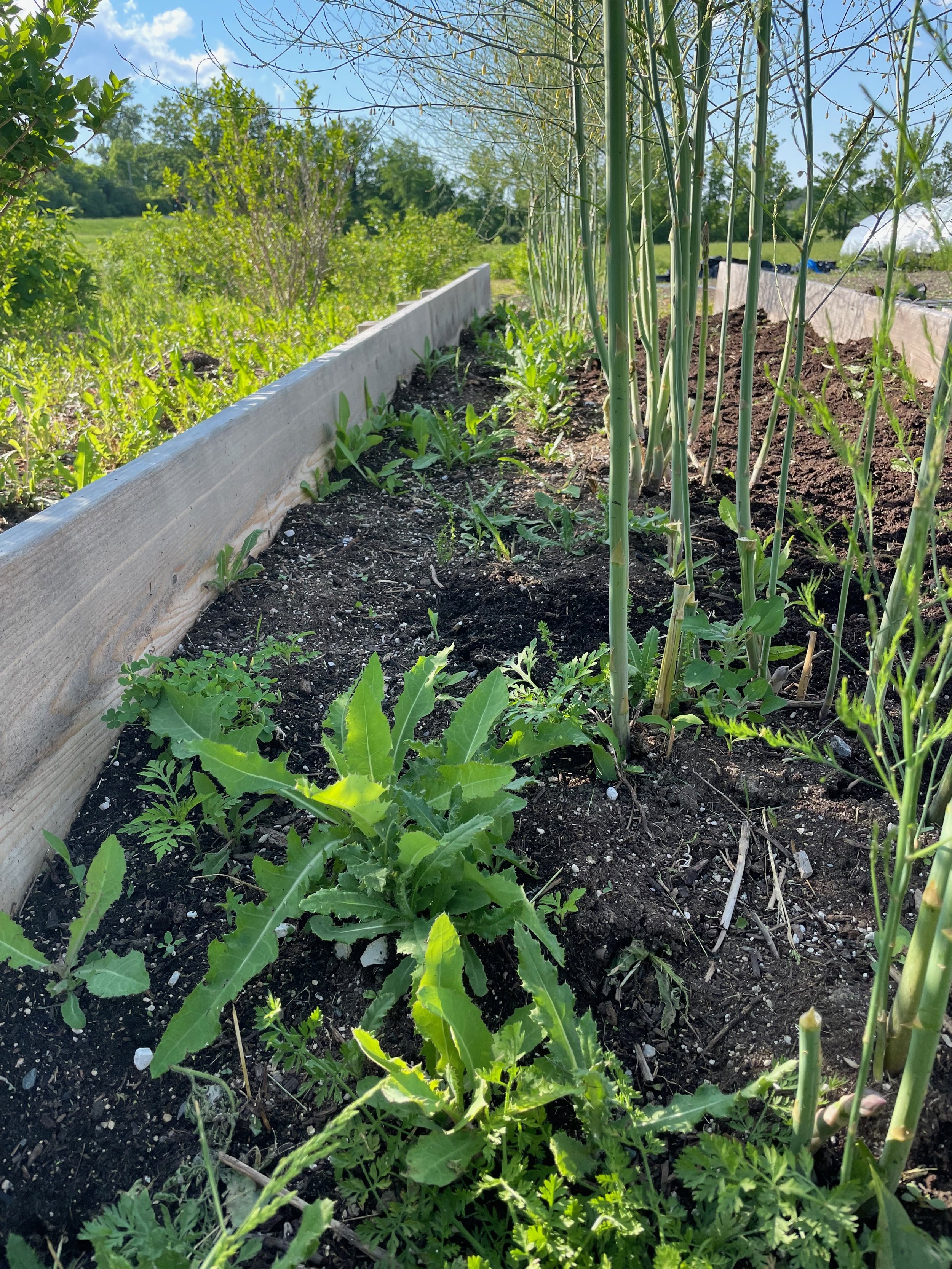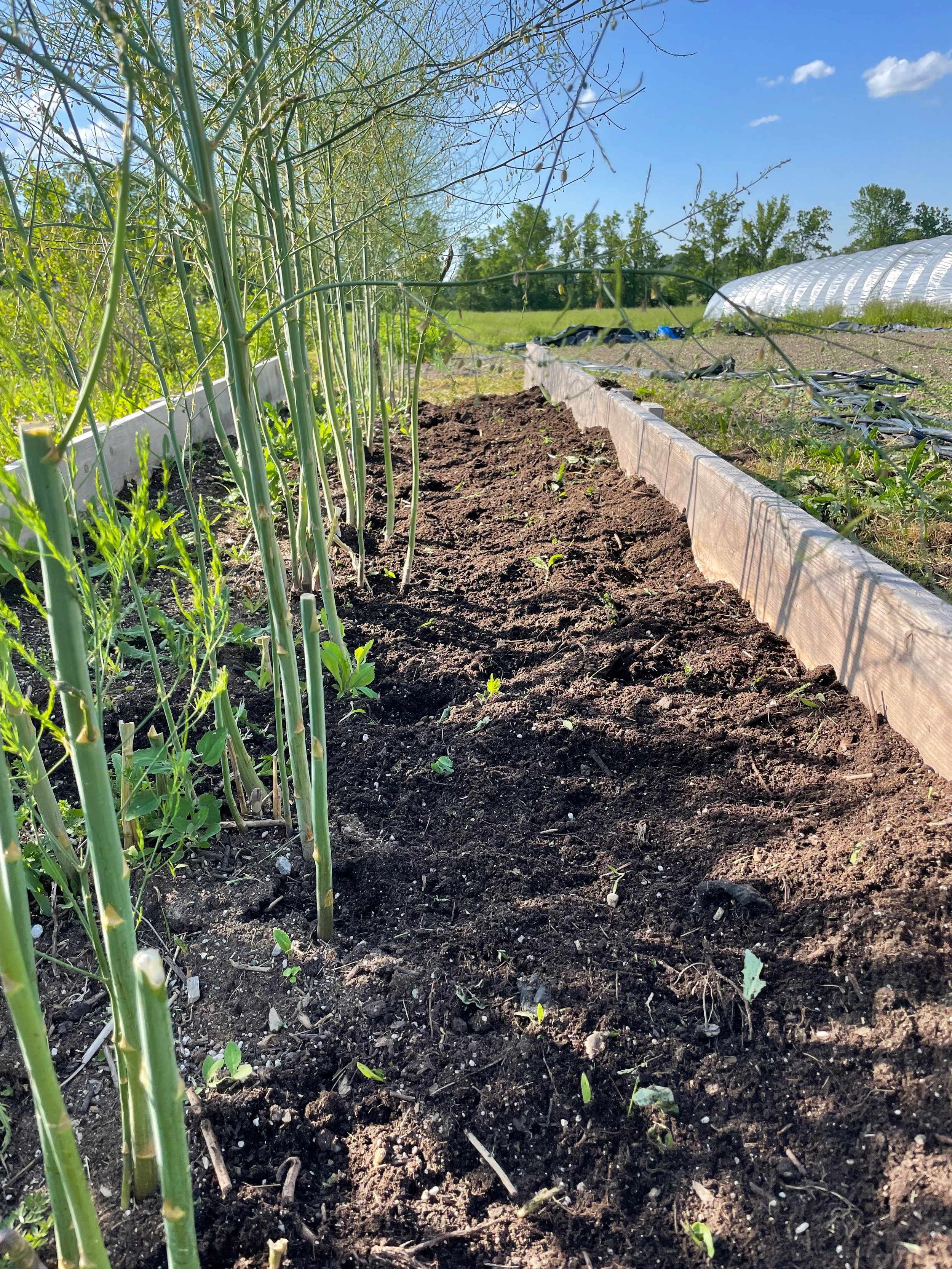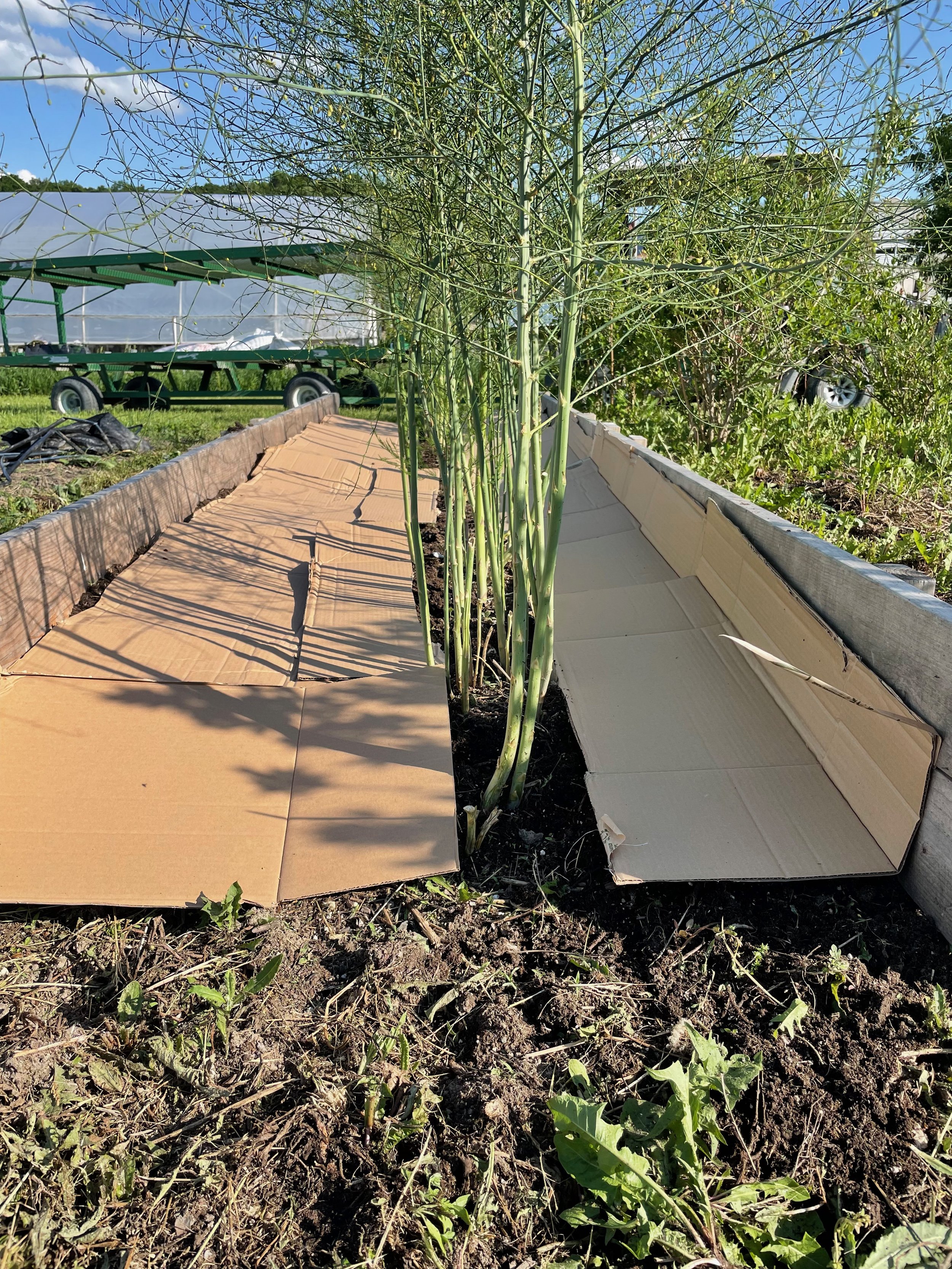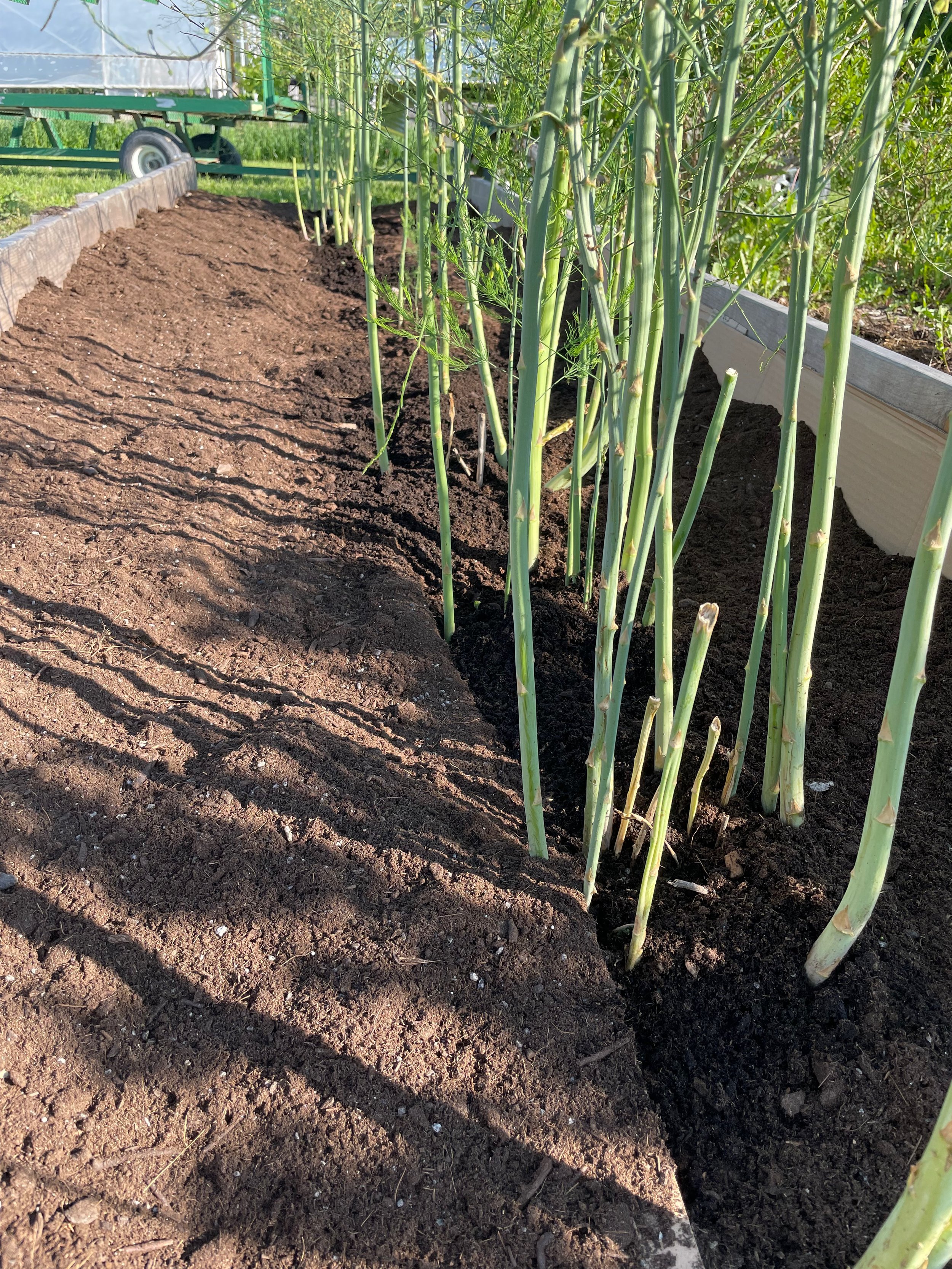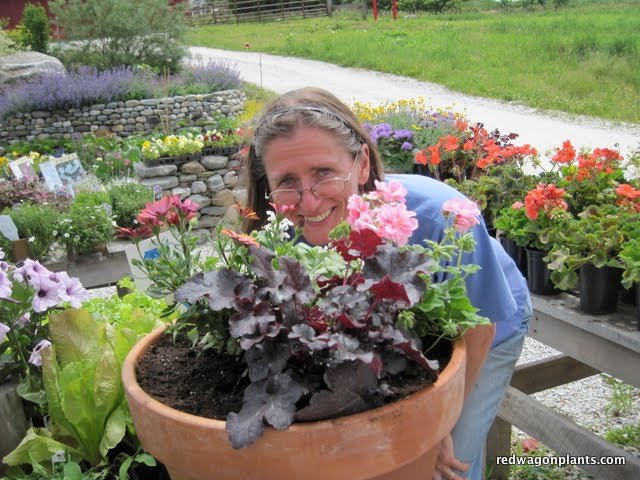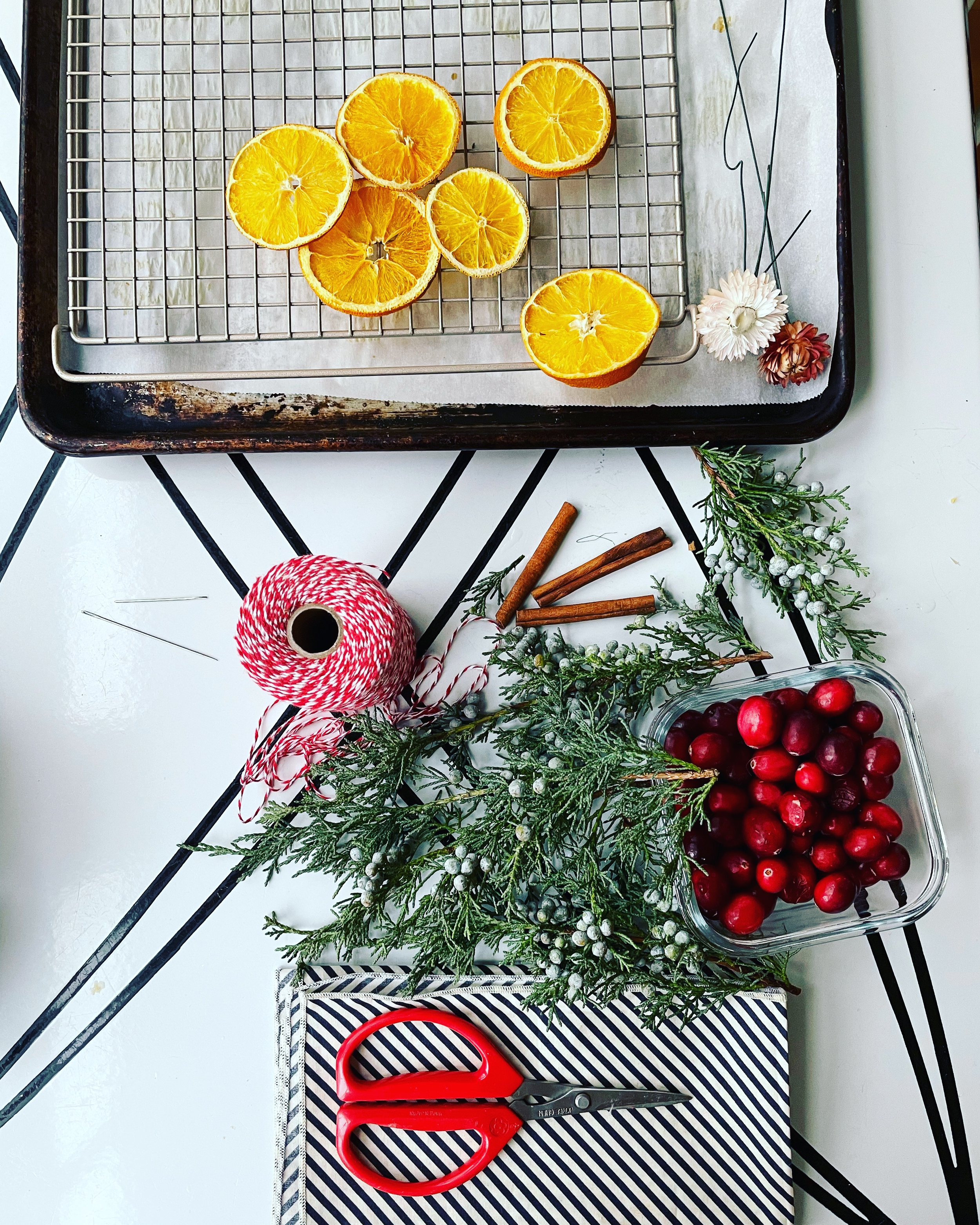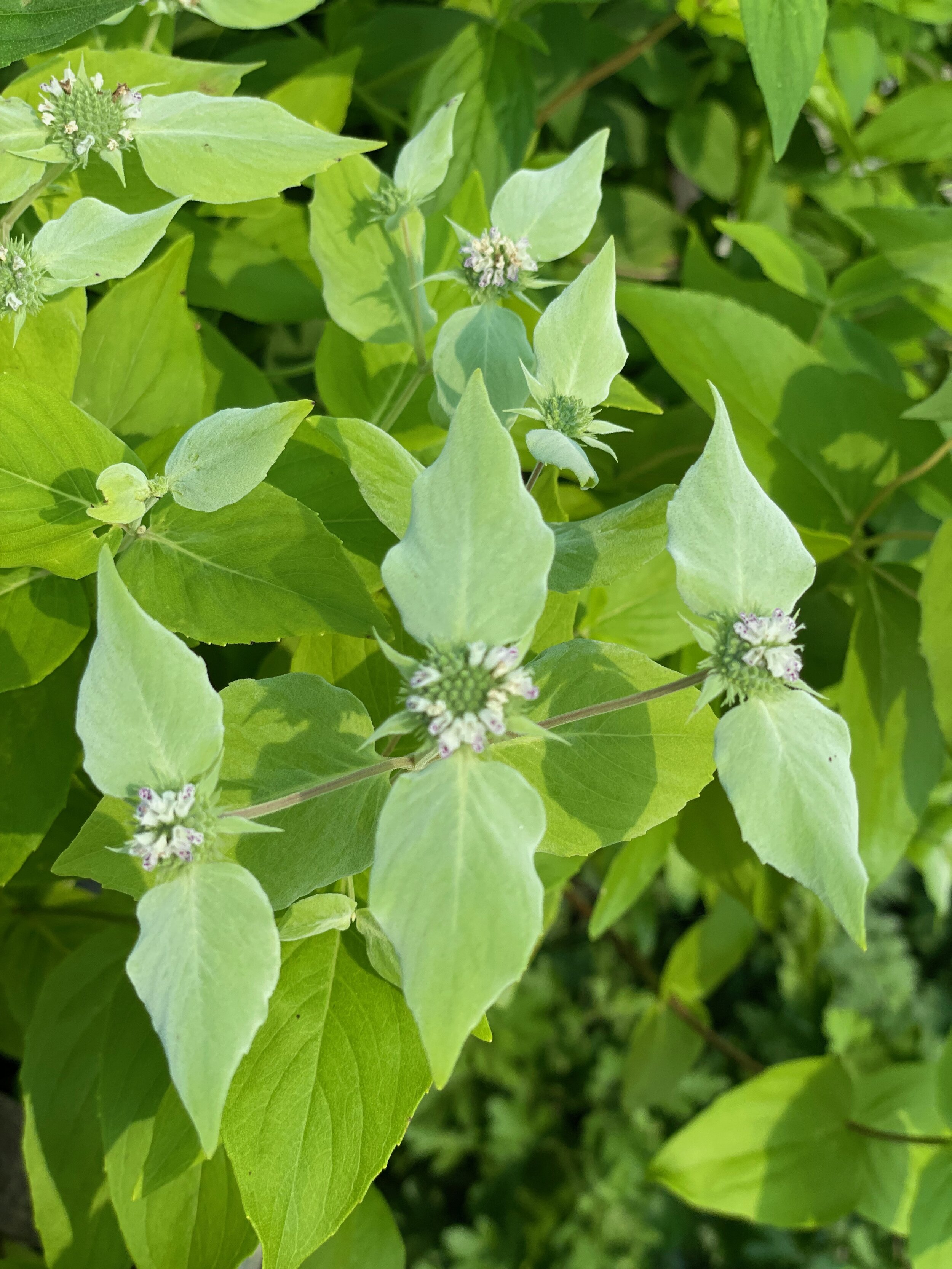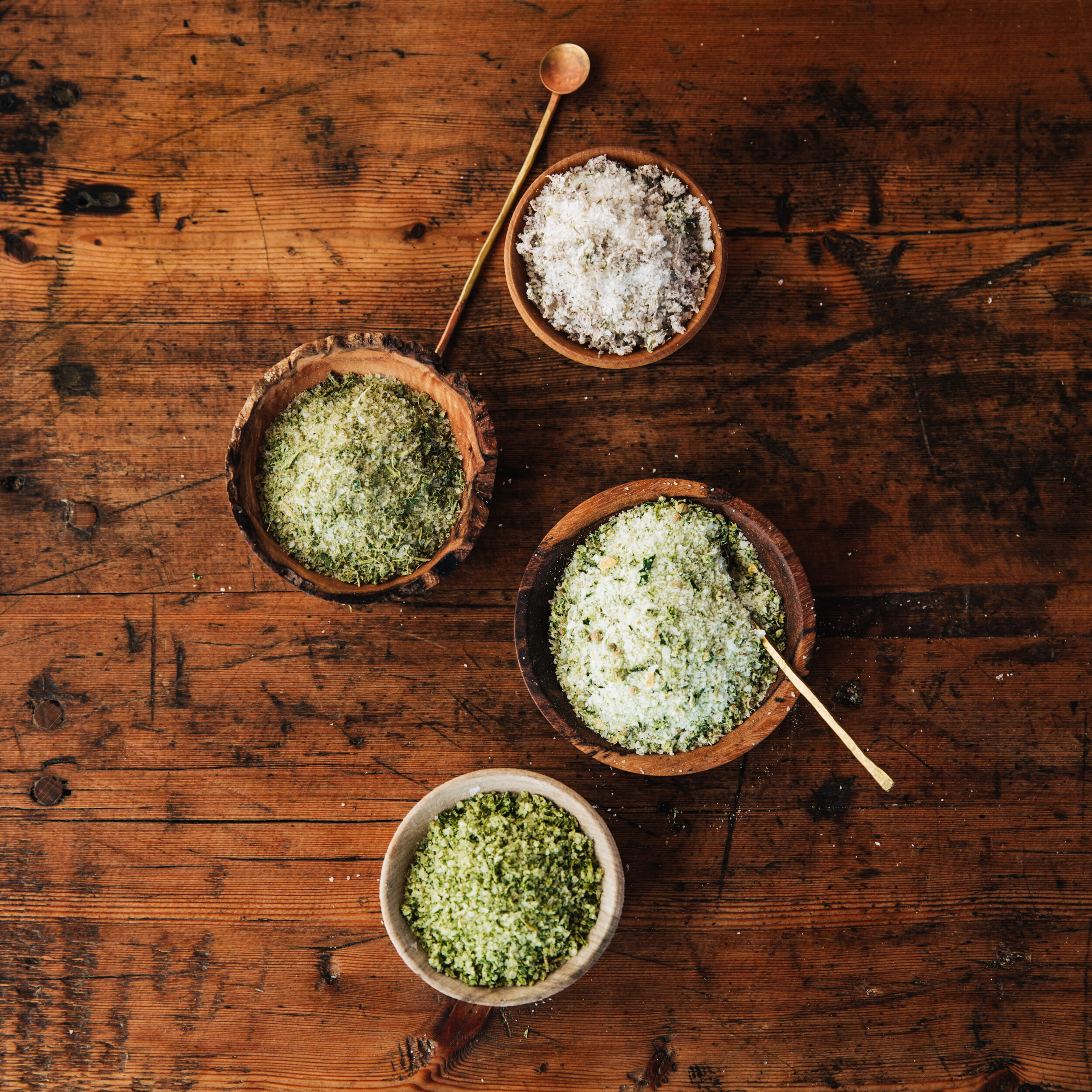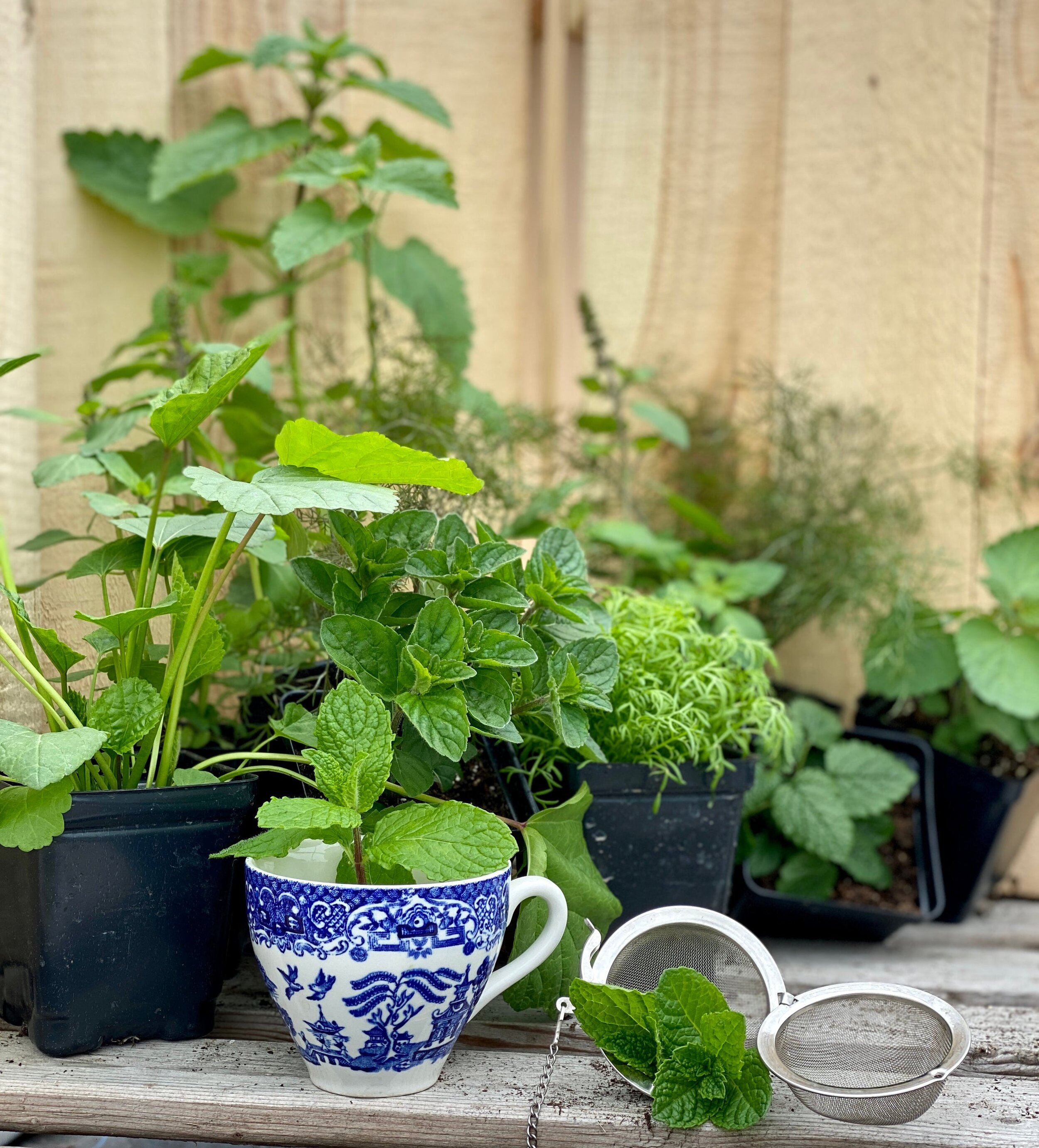Summer Recipes
What to do when it is too hot to cook? Salads and iced teas are the answer along with some simple ideas like these garden to kitchen solutions:
slice radishes, cherry tomatoes and cucumbers and dip in herb salt
have a salad bar ready to go at all times - washed greens, a big batch of vinaigrette or other dressing, containers of chopped herbs, peeled and sliced cucumbers, beets (cooked, peeled, sliced), grated carrots, some cheese or cold chicken chopped up
hard boiled eggs in a bowl in the fridge. Peel, cut in half, sprinkle with herbs and herb salt.
herbal teas in half gallon mason jars made with sprigs of mint, lemon balm, and/or lemon verbena
grill up zucchini and summer squash in the cool of the evening and toss with olive oil, herbs, and flaky sea salt. Serve as a room temperature salad with some freshly grated parmesan, lemon zest and a squeeze of lemon.
pre-salt your vegetables to tenderize them and make them crunchy at the same time. Our herb salts are a great tool for this technique. We suggest about 1/2 tsp of salt for every 4 cups of sliced cucumbers, summer squash, zucchini or cabbage. Slice or julienne or shred the vegetables, toss and gently massage with the herb salt, and let drain in a colander for an hour or so. After this rest period, the vegetables will have a great texture. Taste for saltiness, and rinse if they seem too salty. They are ready to eat in salads dressed simply with herbal flower vinegar or lemon juice, a good olive oil, and a generous shower of herbs such as basil, parsley, dill, cilantro, oregano, marjoram, mint or chives. The flavors will pop!
SUMMER SALADS
We leave behind those tender lettuces that wilt and bolt in the heat and embrace some hardier textures. And maybe you did not replant lettuce to have some nice fresh heads right about now. Have no fear, shame or guilt…other options for summer salads out of the garden are bountiful. Here are a few favorites that all work well at room temperature and hold up reliably for picnics or packed lunches:
Fennel and herbs - using a sharp knife or a mandolin, shave fennel bulbs into thin slices. Toss with a handful of chopped herbs, thin slices of sweet or white onion, and a simple lemon and olive oil dressing. Sprinkle with herb salt generously, and then let the mixture sit for at least an hour before serving. The fennel will soften and become tender and crunchy at the same time.
Summer Squash - follow the same exact instructions as above, but use raw summer squash or zucchini sliced into thin ribbons with a mandolin or vegetable peeler. We love this one with a little garlic in the dressing and marjoram as the herb.
Grilled eggplant and cherry tomatoes - roast or grill 1/2” thick slices of eggplant that have been brushed with olive oil until they are tender. Allow to cool, then cut into wide strips. Toss with halved cherry tomatoes, scallions that are thinly sliced, and torn basil leaves. Dress lightly with olive oil and balsamic and shower with our herb salt or a flaky sea salt.
IT IS THE SEASON OF BEANS
We love green beans, wax beans, and Romano beans for simple, weeknight meals:
Salad - Blanch them in boiling, salted water for a few minutes until tender. Drain and cool down under cold, running water. Dry well on clean kitchen towels, then toss in a big bowl with sliced scallions, halved cherry tomatoes, herbs, and a simple vinaigrette.
Stir fry - If you have more blanched beans than you can eat in one meal, save some for another night to make a quick sauté in olive oil with sweet onions, sweet peppers, and herbs of your choice. This is a great side for roast or grilled chicken.
Roasted - Lay raw beans on a sheet pan, drizzle with sesame oil, finely chopped garlic and/or ginger, hot pepper flakes, soy sauce or tamari, and toss together. Place in a pre-heated 400F oven (or grill if you don’t want to heat your house) for about 20 to 25 minutes, flipping part way through. They should be charred in places, and soft in others.
This blog post was written by Julie Rubaud and Kat Consler.
Very Berry Weekend
Let’s celebrate berries in all their colorful delicious beauty.
To celebrate the start of berry season, we invite you to a weekend of very berry fun. We are offering a palette of berry themed workshops and classes as well as free activities and learning opportunities with topics ranging from growing your own fruit and plant care to turning your harvest into tasty treats. You’ll also have a chance to weave your own harvest basket. To round out the weekend fun, we will have delicious berry-packed lunch, snack and drink options available for purchase.
VERY BERRY WEEKEND SCHEDULE
Saturday June 8
10:00 am - 5:00 pm BASKET WEAVING workshop: BLACK ASH BERRY BASKET with penny hewitt
Here is a unique chance to make your own basket and in the process learn one of the oldest crafts in human history. For thousands of years, baskets have served as indispensable objects in every culture. Let's carry on this tradition and take home a beautiful, durable and useful berry basket, crafted from local and responsibly harvested, hand-pounded black ash logs. This is a great introduction to the extraordinary qualities of the black ash tree. In this class, participants will weave a square to round basket, approximately 6”x 6” with optional leather strap. Included is a discussion on how the material is harvested and processed.
Cost: $165. Limited to 12 participants. Sign up here.
12:30 PM - 1:30 PM BERRY GROWING Drop-In
Drop in for this free berry growing session. You may learn how and when to plant strawberries, which blueberry varieties might suit you best, or how to prune raspberries. Bring your berry curiosity. No sign-up required.
Sunday June 9
10:00 AM - 11:30 AM Growing berries in Vermont with Jacob Holzberg-Pill
From the common to the lesser known fruit, this class will cover all the bases to get your backyard berry patch going. Vermont’s climate brings its unique challenges and opportunities for berry production. Participants will learn which varieties to choose depending on their site and how to care for them. This includes propagation to multiply your plants, and pruning to keep them healthy.
Cost: $25. Sign up here.
12:30 PM - 1:30 PM BERRY GROWING Drop In
Drop in for this free berry growing session. You may learn how and when to plant strawberries, which blueberry varieties might suit you best, or how to prune raspberries. Bring your berry curiosity. No sign-up required.
4:00 PM - 6:00 PM HANDS-ON, honey-Based jams with v smiley
What better way to celebrate berries than turning them into jam with local honey and fruit. In this class with V Smiley from V Smiley Preserves, you will learn how to make delicious berry jams with local ingredients. The class covers selecting, preparing and preserving fruit with honey and without added pectin. V Smiley will teach the fundamentals of flavor construction and the stages of jam cooking, using honey instead of sugar. Through tasting a wide selection of preserves and making variations on two berry jams, you’ll open up your jam making to the spice cupboard and herb garden. This is a hands-on workshop and you’ll head home with multiple jars of berry jam.
Cost: $120. Limited to 12 participants. Sign up here.
We look forward to seeing you! Our greenhouses will be open regular hours, 8:00 AM to 6:00 PM.
Gardening 101 Extravaganza
A full day of learning in support of newer gardeners.
This is our first ever all day learning event. Our goal is to be welcoming and supportive of new gardeners. Throughout the day we will offer many opportunities to explore the basics of growing your own food and flowers and dreaming up your ideal landscape. In this new learning format, we have a whole day of activities planned and you are welcome to come for just one component or stay the whole day.
GARDENING 101 SCHEDULE
Saturday, April 20th
ASK ME ANYTHING ROUNDTABLES — 10:00 AM to 4:00 PM
Join us around the table to discuss your gardening questions with a Red Wagon expert as well as fellow gardeners. This is a free drop-in station where you can get inspiration and find answers, and no sign-up is required. Different members of Red Wagon’s team will be staffing the table and each block of time will focus on a specific theme.
10:00 am - 12:00 pm Plan your garden and create a vision board with Julie Rubaud
We are going analog! Whether you’re designing your veggie garden or your perennial beds, we invite you to get creative and dream big. All materials will be provided but feel free to bring in your own pictures, magazines, Pinterest board or favorite garden journal. This is a free “drop-in” program and you can come and go as you please. No prior registration required.
12:00 PM - 2:00 pm FOCUS on soil, from testing to amending with Chad Donovan
If you have ever sent in a soil sample and don’t know what to do with the results or you’re curious what healthy, fertile soil looks like, this is the time to stop in. This is a free “drop-in” program and you can come and go as you please. No prior registration required.
2:00 pm - 4:00 pm Focus on Seeds - starting them indoors, outdoors, reseeding and more with Kat Consler
Some plants like to be transplanted, others prefer to have their roots be undisturbed. Kat will help you determine the best way to get your plant babies off to a great start. This is a free “drop-in” program and you can come and go as you please. No prior registration required.
WORKSHOPS
Three workshops fill out this Gardening 101 day. They cost $25 each and are limited to 12 participants so we recommend that you sign up ahead of time.
10:00 am - 11:30 am Vegetative Propagation with Jacob Holzberg-Pill
Learn how to make more of your favorite plants with Jacob Holzberg-Pill. This workshop will offer a broad overview on many different types of vegetative propagation: crown division, root cuttings, scaling, tip layering, softwood and hardwood cuttings. In this hands-on workshop we will explore which asexual techniques work best for different species and genera. Participants will practice some of these techniques and take home some fun new plants. Sign up here.
12:30 Pm - 2:00 pm Favorite tools for the veggie garden with Julie Rubaud and Kat Consler
We all have our favorite tools to use in the garden. From trellising supports and row cover to weeding tools and gloves. Julie and Kat will talk about their successes and failures with various materials and how to get the most use out of their favorite garden tools without having to purchase too many things. Sign up here.
3:00 PM - 4:30 pm Growing Cut Flowers with Lily Belisle
Are you dreaming of endless summer bouquets? Lily will help you make that dream come true. In this class, she’ll talk about her favorite cutting flower varieties and which flowers and foliage plants to grow and harvest to keep bouquets on your table throughout the seasons. You’ll get tips for successful growing and learn which tools to use to increase abundance and ease. Please bring all your cutting flower questions and leave with inspiration and plant wish lists. Sign up here.
We look forward to seeing you! Our greenhouses will be open normal hours, 8:00 AM to 6:00 PM.
Growing Ginger in VT
Fresh ginger is juicy and tender and the fragrance will make your head spin.
Zingiber officinale, or ginger, is a tropical plant, native to Southeast Asia. It grows attractive, bamboo-like foliage and has aromatic, fibrous rhizomes at soil level.
This year, as an experiment, we are growing ginger in small pots for home gardeners curious about trying a new crop. We will be offering these starting this Friday, June 16th. We only have 25 pots to offer, and they are first come, first served. This has been a labor of love with the ginger slowly coming to life on heat mats in our shade house (#3) after being planted back in early March. It is finely sprouted and growing enough to send off to your homes.
Growing in VT
Ginger needs warm, rich, well draining soil. It prefers part sun, frequent watering, and regular fertilizing. We recommend growing your ginger plants in a large container or raised bed. A 5 gallon grow bag would be great.
Details
Fill your container with great soil that is nutrient rich and well draining. We recommend Fort V from VT Compost Company. Gently separate your ginger plants and space them in your container. As the plants are getting established keep them moist, but never too wet or the roots will rot. As the plants grow, fertilize with a couple handfuls of Compost Plus every week or so. Keep them well watered. At the end of summer, before frost, gently dig out your ginger rhizomes and enjoy this tender homegrown treat.
Each pot has 3 to 4 ginger sprouts in it, and will yield, in ideal conditions about a half pound of ginger.
Fresh ginger should be kept in the refrigerator or frozen for longer storage.
Grow your own bouquets from our plant starts
Nigella add lots of texture with their lacey leaves, bright blooms and geometric seed pods
Who doesn’t love a bouquet of fresh flowers brightening up their indoor living space?
Whether you’re new to growing your own cut flowers or want to expand your bloom options, Red Wagon Plants has a wide selection of flower starts for your garden! We’ve put together a list of plants available at our greenhouses this season and sorted them by function in a flower arrangement. If you’re new to growing cut flowers, I recommend starting with the ones marked for long vase life. Zinnias and Verbena bonariensis for example, are great staples that we like to grow in our display garden every year. They bloom proliferously throughout the summer and have long stalks to make bouquets of any size. They also are great attractors for pollinators!
The images above are Breadseed Poppies and a wheelbarrow full of Dahlias from Lily’s garden.
To find pictures of all the above-mentioned plants, visit our “What We Grow” page on our website.
A few top picks are described in the following guide:
Gomphrena make great dried arrangements
If you would like more inspiration and guidance on how to grow, harvest and arrange your cut flowers, below are some of our favorite resources. And as always, stop by at our greenhouses in Hinesburg and let us help you make the best selection for your garden.
This post was written by Kat Consler.
How to start your own backyard blueberry patch
Growing blueberries in your own back yard can be very rewarding. Picking the plump ripe berries make a great fresh snack for young and old!
Here are a few things to pay attention to when planning your new blueberry patch:
Cross-pollination: Like many other backyard fruits, you will need to plant at least two varieties to get good cross-pollination and fruit set. Following is a list of varieties that we carry or have carried in the past. Personally, my favorites are ‘Northland’ for their exceptional flavor reminiscent of wild blueberries and ‘Bluecrop’ for their large clusters that make for easy picking.
Your soil pH: Select a sunny site in your garden and then get your soil tested! Blueberries will only thrive in acidic soil and most garden soils will need to be amended with a soil acidifier. This is the same product you would use for hydrangeas.
Spacing: Give your blueberry bushes enough elbow room. Depending on the varieties chosen this will be 4-6 feet of space between the plants. Check the tag on the plants you purchase to know their mature size and recommended spacing.
Take your time: For the best success and least maintenance, plan ahead and prepare your planting spot in Fall, then plant in Spring as soon as the soil warms up enough to work it. Blueberry bushes can be planted any time of year but will require good watering (mulching helps!) and weeding especially in the first few seasons. As tempting as it is to let your berry bushes fruit as soon as possible, it is recommended to remove all flowers in the first year. This way your plants can put all their energy into growing a healthy root system. That will in turn give them more energy to bear more fruit the next season. Patience pays off.
For more growing and maintenance tips, please refer to this handy growing guide or come by in our greenhouses and ask one of our plant experts!
This post was written by Kat Consler.
Cleaning up the Asparagus bed
After producing all spring, asparagus benefits from a clean up and some fertility. First, weed the bed carefully using a knife and your hands. You want to cut the weeds out and gently remove them without disturbing the asparagus roots.
After weeding.
In order to not disturb the roots later in the season, it is important to prevent weeds from growing during the summer. I laid down cardboard along both sides of the row. This is a young asparagus patch, and still growing in a row. If yours is older, it is likely much wider than this or growing in a circle or oval. If that is the case, mulch the whole perimeter with cardboard.
I use Perennial Blend and compost from VT Compost Company. The Perennial Blend covers the cardboard, which will later break down, turning into soil along with the Perennial Blend. The compost is applied right to the crown of the asparagus and will feed the plant which will in turn feed the roots to make a great patch for next year.
The darker compost is in a strip right over the asparagus crowns. The lighter soil is the Perennial Blend. It hides the cardboard (which blocks out the weeds) and both will break down to feed the soil and the asparagus.
What is Hope up to in the Garden?
Here is a little update from Hope Johnson about what she has been up to in her garden. Hope is an unmatched talent in many departments and creative ventures including quilt making, garden design, and as an advocate for bees and pollinators. We always look to her for inspiration and now you can too!
She says:
Turned the compost which is now thawed enough to do so.
Pruned back and reduced the bed size of the Fall Gold Raspberries. Added a dusting ofwood ash (not enough to alkalize but good for potassium), lightly weeded and mulched a lot.
After a very positive experience growing winter squash last year, I am expanding my vegetable beds in the sunny area of my yard since the star magnolia has turned my kitchen garden into a part-shade environment with the consequence of inadvertently growing miniature vegetables.
NO DIGGING. Put down a generous layer of partly decomposed horse manure and bone meal, then wet cardboard, and a layer of locally sourced leaves (from my lawn) and straw. By planting time in late May, I think the microbes and invertebrates will have done their thing and I'll addhomemade compost to each planting hole.
The garlic is up and I planted two new varieties this year, Duganski and Vietnamese Red.
Edible Annual Flowers
Many of our beloved annual flowers have applications beyond their beauty in the garden or the vase. You may already be growing edible flowers without realizing it! These flowers are great for adding color and flavor to summer dishes or freezing in ice cube trays for magical floral beverages. Choose from this list when growing a kid-friendly cutting garden to allow for as much hands on interaction as possible.
It’s important to note that “edible” does not necessarily translate to “delicious”. But many of these flowers do offer a nice addition of flavor, and those that are more bland or bitter are still worthwhile choices for decorating cakes or using as a garnish.
Additionally, as with anything headed for the kitchen, it’s important to either grow from seed or purchase plants from an organic greenhouse like Red Wagon, so that you know they haven’t been treated with chemicals that would render the flowers less than lovely to eat.
Stock and Sweet Alyssum, both edible flowers in the Brassica family
Sweet Alyssum (Lobularia maritima): This sprawling member of the Brassica family has the four-petaled flowers that identify that genus, and the leaves and flowers are characteristically peppery. Include in an arugula salad for some color and extra zing. As a bonus, alyssum (and its bigger cousin, the Lobularia cultivar) provide some helpful early pollinator habitat and pest protection when planted in the vegetable garden.
Violets and Pansies (Viola spp.): The colorful violas and pansies found early in spring at the greenhouse are nearly identical to those sweet spring flowers poking through the grass in your backyard, and all parts of the plant are edible. The fresh flowers have a sweet, almost wintergreen-like flavor and look gorgeous when candied and pressed into cookies or iced cakes.
Calendula and Marigold (Tagetes spp.): We’re such big fans of these two genus we made a whole other blog post about them! Calendula has long been used as a tea herb, and the different marigold species have a wide array of edible and medicinal uses dating back to Aztec times.
Bachelor Buttons (Centaurea cyanus): One of the easiest “true blue” flowers to grow, Bachelor’s Button flowers also come in a sweet array of purples, whites and pinks, with a mildly sweet and vegetal flavor. The petals retain their blue color quite well when dried, so be sure to harvest and dry some to brighten up herbal tea blends this winter.
White Snapdragons against a backdrop of African Blue basil
Snapdragons (Antirrhinum spp.): While the flowers of this eye-catching species certainly aren’t going to win any taste tests (they are typically described as “bland” and “bitter”), they are in fact edible. Pluck the petals from the bitter base of the flower and arrange on a platter to create a showstopper garnish for any summer meal.
Nasturtium (Tropaeolum spp.): Nasturtiums are one of the most commonly used edible flowers, and are well known for their bright, spicy flavor. Add leaves and flowers to salads, infuse a flower vinegar, pickle the buds and seed pods… the possibilities are only limited by your imagination and affinity for their peppery bite.
Stock (Matthiola incana): A longtime favorite of florists, four-petaled stock is in the Brassica family like sweet alyssum. The flowers are peppery and clove-like, so try adding them to salads or atop grilled fish and vegetables for a colorful kick.
Dianthus (Dianthus caryophyllus): The annual species of this classic carnation has been in cultivation for well over 2,000 years. The flower petals are fragrant and have a mild clove-like flavor, perfect for adding to iced beverages and fancy desserts. Pluck petals off the bitter green base before use.
Scarlet Runner Bean ‘Painted Lady’ (Phaseolus coccineus): This vining relative of the common bush bean is native to the highlands of Central America. The beautiful red and white flowers can be enjoyed as a snack or in salads, or left to ripen to mature beans which can be eaten fresh or dried down.
Hyacinth Bean Vine (Lablab purpureus):This gorgeous vining bean is similar in habit and use to scarlet runner bean, and has been cultivated as a food crop in Africa and the tropics for millenia. The elegant purple leaves make a good cooking green, and the beans are edible when fully cooked.
Ruby Moon Hyacinth bean vine
A year for growing and learning
Welcome to a new year, friends. We are putting together our workshops and classes for the 2022 season and would love your help. Would you let us know more about your garden learning goals for this year and what type of events you would like to attend, virtually or in person? We cannot wait to hear your thoughts, and we have created a quick survey for you to fill out. It should take less than 5 minutes, and to thank you we will enter you in a raffle to win a complete set of our homegrown and handmade herb salts and vinegars. Thank you so much for your time and help. We cannot wait to see you all soon.
Cheers from Julie, Sophie, and Sarah - the Red Wagon Community Outreach Team
Simple Gifts
I have been drying orange slices and making all sorts of simple holiday decorations this past week. It is a fun and uplifting way to get into the holiday spirit or to honor the return of the light at solstice.
Hello and warm wishes from all of us at Red Wagon. I just wanted to pop in and give you a little reminder that this coming Friday, December 17th, will be our last order pick up for any purchases you make in our online store. If you would like any gifts for the gardener or the cook on your list, or you want to treat yourself to a little something, here is your chance!
Our suggestions:
Our cute new gift packs of herb salts are the perfect hostess gift, all ready to go. You can find those here. Each package is lovingly packed and dressed up with a cotton ribbon and includes a wooden miniature salt cellar and salt spoon.
This sickle weeder is easily everyone’s favorite hand tool at Red Wagon Plants. I never step into the garden without it if there is weeding to do.
The Hori Hori knife is also a staple in my garden tool box. It is so handy for making a planting hole, digging out tough roots, or cutting back fibrous stems.
While this won’t win “Most Romantic Gift”, we think that any serious houseplant owner would be thrilled to receive a bag of potting soil or Compost Plus made by our friends at VT Compost Company.
And these gardening gloves are a sweet little gift that will fit into a stocking or parcel just fine. They are another favorite of mine that I stash in my tool box, car, and garden shed. You never know when you might want to get your hands in dirt!
Finally, thank you for making 2021 another amazing season for us. We are excited for our future with you, and have lots of new developments that we will be sharing soon. Your love of plants, nature, and people is what fuels us.
With love from our gardens to yours,
Julie and the crew
Last Week of the 2021 Season
Our last week of the season!
Thank you for gardening this year, and for supporting us in all the incredible ways that you do. .
Thank you for gardening this year, and for supporting us in all the incredible ways that you do. Without all of your interest in gardening and plants, we would not be here. Our work is fun, and meaningful in every way, and attracts such a great team of people, both as workers and as customers. I am so grateful to each of you for another wonderful season. July and August have been a little more quiet than normal, and I am guessing it is because of the rain and the ability to travel and visit. I know my own garden has suffered its share of neglect due to its absentee owner. But this week, I am vowing to turn that around and spend 3 early morning sessions cleaning up, cutting back, and putting in a few new plants. Maybe you are feeling a little need to tame the jungle too? I welcome you to follow along and help keep me accountable in this late August push. I am happy to help you do the same. Share your goals and projects with us. You can tag us on social media, or send us an email, or even better, come in this week and give us an update. We love to hear from you.
In the Garden
My 4 projects this week in the home garden:
Redo my herb planters for fall. I am ripping out old basil, cilantro, dill and planting fresh for fall.
Cut back some very tired looking perennials that melted in the rain.
Pull out some thugs, and replant with some better behaved plants.
Rein in some of the plants along my gravel path - mainly Geranium ‘Rozanne’ (Cranesbill) and Stachys ‘Helen von Stein’ (Lambsear)
I will take some photos before and after each session. Feel free to follow along on Instagram or Facebook.
In the vegetable gardens at work, I will continue to lay in successions of greens for the fall. I am harvesting tomatoes, eggplants (finally) and peppers non-stop.
In the Kitchen
I have been making lots of yummy things with all the produce:
Refrigerator pickles with the hot peppers. I use them in everything! The pickling mellows out the heat, and I take out a whole pepper, chop it fine, and add it to morning eggs, tacos, ricotta for stuffing other veggies, etc.
Bread and butter pickles with cucumbers
Eggplant parmesan
Baba Ganoush
Roasted eggplant, fennel, sweet onion, tomatoes, herbs and garlic for the freezer
Peach Jam
Plum Jam
Peach Bourbon BBQ Sauce
Brandied peaches
Frozen blueberries
Blueberry tart
Blueberry sauce
Full disclosure - I have purchased eggplant and cucumbers and blueberries. Thank you, Old Road Farm, Steph, Adams Berry Farm and Sweet Roots Farm! I did not have great success with the eggplant in our heavy clay soils this year due to all of the rain. And our cucumbers all died due to a virus early in the season. Yes, these things happen to everyone and I we are fortunate to have fabulous farms in this area who work magic with soil and seeds no matter the weather. And a giant thank you to my friends Amy, Matt and Yvan for the peaches and plums. I am very lucky to have exceedingly generous friends with thriving home orchards.
I am happy to share recipes if you would like any.
In the Greenhouses
Our “Plant of the Week” deal is once again a whole group of plants, not just one. Here is the scoop: you buy 3 perennials and or shrubs, and we give you a fourth 1 free. It is ok to mix and match, and the lowest priced item will be the freebie. It is a great time to stock up on plants for the future planting projects (keep them watered until you get to them) that can happen a little later. Maybe once the kids are back in school, you can steal away into the garden for a few hours and pop in your new plants.
We are cleaning up, and starting the maintenance projects that keep our crew busy into the fall and winter. The herb farm continues to produce beautiful and fragrant harvests twice a week, and the indoor herbs are doing really well in their new beds.
Herb Salts, Plant of the Week, Garden and Kitchen Update
YUM. We are very excited to share this week’s Plant of the Week deal. Any remaining berry plants we have, are available for the Buy One, Get One Free promotion. This includes the following:
Strawberries - Alpine strawberries in 4-packs that can be used for edible landscaping, and as a perennial ground cover in sun to part-shade; and ‘Mara des Bois’, French ever-bearing strawberries that are in hanging baskets, but can be planted in the ground for years of enjoyment.
Raspberries- a few varieties, including summer bearing and fall bearing
Elderberries- hardy, easy to grow native plants that are good for making plant medicine as well as attracting wildlife, creating a hedgerow, and for their fragrant flowers that can be eaten or turned into tea or cordials.
Blackberries - a hardy, thornless variety that produces huge blackberries
Gooseberries - an old-fasihoned fruit that is great for jams and preserves
August is a great time to plant berries of all kinds, and leaves them plenty of warm days to establish healthy root systems so that will support them for years to come. Our “Plant of the Week” promotion lasts until Sunday, or while supplies last, whichever comes first. Quantities are limited.
In the Garden
The next few weeks are the funnest part of the gardening calendar in my mind. The weeds are under control, we are in harvest mode, and there are lots of empty spots to fill in with plants for the autumn bounty. Going in this week: more escarole, radicchio, lettuce, scallions, spinach, cabbage, broccoli and sprouting broccoli.
I have harvested garlic, shallots and sweet onions. If you haven’t done it yet, you probably should this week. The storage onions - yellow, red, and cipollini - look almost ready in our garden. I will check them later in the week, and if I see that lots of the tops are laying down, I will pull them all out of the soil. I usually wait for about half of them to be fallen over as a sign that they are mature enough to cure well and develop those papery skins that allow them to stay firm in storage all winter long. If you are not sure if your onions are ready, send a photo and we can help you decide.
In the flower garden, Lily has been deadheading her zinnias and recommends making a bouquet to give to someone. It feels good. She has a new baby niece who turned one week old today, and was the lucky recipient of said bouquet. So adorable.
Sara says to check for hornworms in the tomato patch. The earlier you catch and destroy them, the less chance of a full on invasion. Good luck.
In the Kitchen
I have started freezing and canning in earnest, with a big batch of Roma beans taking center stage this weekend. If you have not grown these or eaten them, I encourage you to put them on your list for next year’s garden, or stop by a farmers’ market or farm stand to stock up while summer is still with us. Trillium Hill Farm in Hinesburg has them currently.
Eggplants and peppers are finally abundant in the garden (the rain slowed them down) and I just made a simple dinner with roughly chopped peeled eggplant, shallots, peppers of all kinds, halved cherry tomatoes, torn herbs, minced garlic, a glug of olive oil, and chunks of feta. I laid everything out on a sheet pan and roasted it for about 45 minutes at 375F. What an easy summer dinner, served warm on the deck, or at room temperature for a picnic by the lake. Preferably with an icy cold rosé and a baguette from O’bread or this easy recipe for pita from King Arthur. I spent a good part of the pandemic winter making pita, and I am not mad about that new skill.
Our herb salts and vinegars are now available! We have been busy harvesting and chopping herbs, and curing them in salt for maximum flavor and fragrance. I recommend them all right now, especially to elevate simple garden meals of cucumbers, tomatoes, greens, and grains into something special every night of the week. They are also great for the grilling and entertaining you might be doing outdoors while the getting is good. You can find them at our Hinesburg greenhouses, at City Market, Hunger Mountain Coop, Farmers to You, Intervale Food Hub, Sweet Roots Farm, Trillium Hill Farm, and Philo Ridge Farm. And here online. We are set up to ship herb salts and vinegars. Maybe you would like to make someone’s day by sending some as a gift?
Enjoy the week, enjoy each other.
Julie
Plants of the Week: It's all about the HERBS!
Welcome to the basil forest!
It’s official- harvesting plant medicine has begun in earnest and, depending on who’s in your garden, won’t stop until first frost. This time of year it’s all about the Aster and Mint families.
Blossoms like calendula, chamomile, echinacea and yarrow all benefit from regular deadheading, and create small consistent harvests that lend themselves well to infusions in oil or apple cider vinegar to create soothing topical applications for all manner of skin ailments. Infuse a pint of oil (local sunflower, olive or jojoba are lovely) with freshly-wilted chamomile, calendula and yarrow, then blend with local beeswax for tins of salve. You’ll be the hero of every chapped lip and dry hand you know!
Mint family plants like lemon balm, tulsi, basil, peppermint and spearmint should be harvested when the bottommost flowers on their spikes have begun blooming, or slightly before. Cutting at this time encourages bushy regrowth, and gives you the highest quantity of aromatic leaves and flowers without a lot of stem or seed. Be sure to make yourself a half gallon of fresh mint tea to have on hand in the fridge- plants with high volatile oil content (read: nice and smelly) will last the longest in the fridge, as the volatile oils do double duty inhibiting fermentation. This also clues us in to their amazing ability as general support for our immune system. Harvest on a hot, sunny day and dry quickly in a breezy, warm spot to get the highest volatile oil content from your plants.
Tulsi drying on racks in our greenhouse
We are doing a big sale this week- buy one herb pot, get one free! Culinary staples, perennials, and tea herbs are all available and will continue to produce well into early fall. Come by the greenhouses between 8-6 every day to stock up on herbaceous joy this week!
This is a great time to bulk up your herb garden with a new-to-you plant or more of your favorites. Include a couple of lemon verbena and rosemary plants to make Sophie’s favorite “lazy tea”: Just add a few whole leaves of lemon verbena and a sprig of rosemary to the bottom of your cup, then cover with hot water and steep five minutes. It’s the perfect afternoon pick-me-up, and is even better when steeped overnight and served on ice.
No more room for herbs in the garden? We’ve got you covered! We are now offering bulk fresh herbs for pickup at our greenhouse. Dry sage and thyme for holiday gifts, brew tulsi and anise hyssop tea for your whole cookout, make a cool mint bath for your sunburn… the possibilities are endless!
Building mesh screens to sift dried herbs
We have some upcoming classes for the herbal enthusiast (registration required):
July 20th: Know and Grow your Chicory. Julie and I are teaming up to talk all things chicory- from its use as an ancient medicinal herb, to coffee substitute, to revered Italian vegetable and everything in between. Taste tests included!
August 5th: First Thursdays in the Garden: Chad will be talking integrated pest management this month- how we do it at RWP and how you can at home. Julie will offer a behind-the-scenes tour of our greenhouses. I’ll also be hosting our September 2nd edition to talk about fall herbs!
August 21st: Harvesting and Processing Medicinal Herbs. We’ll dive deep into the different ways to preserve and use the herbal bounty in this hands-on three-hour class, so bring your questions and jars!
Let us know what you’re making from the season’s bounty, and of course come by any day 8-6 with questions, concerns, and success stories. We’re happy to help and love hearing about your garden journeys.
Plant of the Week (POW)
This week’s plant of the week is actually a whole group of plants. We are offering flowering vines, and if you buy ONE, you will get THREE free! They’re a bit tangled together at this point, but they are healthy and dark green, and with a little patience can be untangled and turned into an almost instant trellised green wall. Or make a teepee out of bamboo and let them climb all over the structure. Cover an old fence, create a privacy screen, pull down the gone-by spring peas and replant with flower vines. You get the picture - there are lots of fun uses for flowering vines. Please note, that this is while supplies last. If we run out of vines, we will switch to something else for our Plant of the Week (POW). The selection includes
Cypress VIne
Morning Glories (3 different kinds)
Hyacinth Bean Vine
Sweet Peas
Scarlet Runner Beans
IN THE GARDEN
Maintenance pruning and weeding in the perennial gardens
The rain has been such a blessing this past week. We are now seeing lots of weeds and quick new growth and jungle feeling is real! May I suggest our sickle weeder and our small snips as tools to help you in that endeavor? When the garden is growing so quickly, it becomes harder to get weeds with a hoe, so I turn to my hand tools for a quick cultivation run through when the weeds are small.
If your strawberries have finished producing fruit, it is time to renovate them
mow it down (the whole thing, with a line trimmer)
rototill the edges of the beds to keep the growth in the center of the bed, and out of the walking paths
fertilize the strip of stubble that will remain and become next year’s bed and water it well if we have another dry spell.
Check your garlic. It is ready to harvest when about ⅔ to ¾ of the leaves have turned brown. We will probably harvest ours next week.
Wash and prep your vegetables as soon as you harvest them. Lettuce greens store so much better when they have been washed and dried first. I try to prep everything I harvest as soon as I bring it into the kitchen. Bags of dirty, hot greens just wilt and get ignored, but if I trim, wash, and dry salad greens, I am much more likely to eat a salad with every meal. I have been blanching chard and kale as I bring it home too. I then have an easy cooked green to eat with eggs or add to a taco, or a grain bowl. It makes meal planning a lot easier.
Plant(s) of the Week: A power trio
Tulsi with bee friend. Photo by Sophie Cassel
Happy Solstice! We are finally beginning to see the fruits of our early season labor, as the chamomile and calendula come into full flower, the mints begin to really take off, and the perennial valerian and angelica stand tall. I have been absolutely flabbergasted by the way my second-year lemon balm and catnip plants have bushed out, and have begun cutting them back to dry for winter teas. Any time I harvest plants for drying, I also make a batch of fresh herbal tea. This weekend I gathered
a handful of chamomile
a few sprigs of bronze fennel
a big bundle of lemon balm
I chopped them all into a half-gallon mason jar and let it steep in the sunshine for a few hours before straining over ice for a perfect “sun tea”. A tea like this only exists at a unique moment, and in a unique garden. This snapshot of the season is a great way to get to know your individual herbs.
This week, in our retail greenhouse, we are offering a trio of herbs as our “Plant(s) of the Week”
Anise Hyssop
Tulsi (which we have a blog post about)
Chamomile.
These are a perfect sun tea trio. All three are plants that you’ll definitely want more than one of in your garden, and when you buy these three staple medicinal herbs, you get three free!
You can find me in the garden drinking sun tea, reading, and hanging out with the plants,
Sophie Cassel
Late June Garden Chores
Plant now for this look later in the summer.
IN THE GARDEN
—> Keeping up with the weeds after the rain is a priority. They will all bounce up and make a carpet in no time. For best results, cultivate when the weeds are young, once the soil has dried out.
—> Fertilize onions, leeks, and shallots because this is when they put on the most growth. I use Compost Plus and water once or twice with fish emulsion during the weeks of late June and early July.
—> Stake and prune tomatoes. Keep the suckers pinched off, and the foliage off the ground. Doing this now will keep the plants disease free for much longer. If you have not yet, I recommend mulching under the plants to keep the soil from splashing up on the leaves since this is one of the ways disease can spread. We will show you how to do this on our July 1st Plant Walk.
—> Now is a great time to put in a strawberry or asparagus patch. We have both available as bare root stock and our retail team can explain how to do it if you are not sure.
—> I have planted all the required staples such as tomatoes, peppers, squash, etc, and now I am ready to plant the electives. This week it is the cut flower garden. I have the following combos planned for different spots in the new display garden (which you can see on our First Thursday Plant Walks).
-Marble Arch Mix Salvia, Cosmos, Zinnia ‘Benary’s Giant White’
-Verbena bonariensis, Zinnias ‘Benary’s Giant Mix’ and ‘State Fair Mix’, Rudbeckia hirta
-Statice, Strawflower, Gomphrena, Celosia, Amaranth (all for drying)
-Sunflowers - a crazy mix of all of our varieties
Medicinal Herb Bundles for 2021
2021 is going to be a big year for medicinal herb growing! With ever more people finding joy and solace in tending to plants, many folks are also realizing that home gardening can be more than just tomatoes and pansies. At Red Wagon we’re branching out as well, and growing even more herbs with traditional medicinal uses. Maybe you’re feeling ready to dive in to the world of healing herbs but a little overwhelmed at all the choices available (don’t even get me started on how *all* plants are medicinal!) Our specially tailored herb bundles are a great way to fill your garden with plants that you know you’ll use and enjoy. Additionally, we’ll offer support through educational videos and recommendations all season.
Our pre-made bundles are only available through our online store; you can also find the individual plants in our retail greenhouses when you come to shop in-person.
To help you get to know the herbs, we’ve made introductory videos for all four bundles; check them out on our Youtube channel. In the video descriptions you’ll also find some book recommendations, many of whose authors have their own super-informative youtube channels. Let these resources be a jumping-off point for your own personal experiences and kitchen experiments with the herbs!
Garden Tea Time Bundle: This kit is full of only the tastiest herbs for making fresh and dried teas. If you’re working with herbs and children, this bundle offers kids a safe and yummy way to pick their own medicine.
Skin Care Herb Bundle: This kit makes a great gift for that glowing garden goddess in your life! Infuse oils for salves and make at-home hydrosols (floral waters) with the vibrant herbs in this bundle.
Sweet Dreams Herb Bundle: Whether you need help counting sheep or just a little support getting through the stresses of the day, the herbs in this kit have got your back.
Basic Home Apothecary Bundle: If you’re ready to form long-term relationships with some perennial herbs, this bundle is full of highly regarded medicinal plants that can be harvested from for years to come. These are great herbs to use when learning how to make tinctures (shelf-stable infusions using alcohol, vinegar or glycerine).
You might be wondering how to start working with herbs early this season, in addition to planning and planting the garden. One thing I do in the spring is go through the dried herbs I still have from seasons past. Now is the time to blend up those random dried herbs to make room for this year’s bounty. I also find it much easier to drink a daily herbal infusion when I have it already mixed up in a pretty jar on the counter. Right now, I’m drinking a blend of garden staples like lemon balm, wood betony and peppermint mixed with some early spring wild plants that will be ready to harvest soon: self-heal, nettles, and red clover. These herbs are mineral rich and help support the healthy liver and lymph function to ease the transition from winter into spring.
If you still have a bunch of dried culinary herbs, try mixing them up to use on roast chicken, spring soups (Nettle and potato soup anyone?), or sprinkled on toast with butter and the first radishes of the year. And remember, culinary herbs are good medicine, too!
2021 can be the year you work more deeply with herbs as a part of your everyday life. We look forward to offering more resources, and hearing about your experiences in the garden this growing season!
Blast Off!
The last week of February is when we typically start up the greenhouses. That means we turn on the heaters, run the water, clean up and sanitize all the surfaces of each greenhouse, and get some seeds into the soil. Our spring starts now, with more time in the greenhouse touching plants and dirt and feeling the sun warm us up. While we fast track ourselves out of winter with the help of the greenhouses, here are a few things you could do at home to follow along.
Start seeds. If you have grow lights, now is a great time to start leeks, onions, shallots, and certain perennials. If you don’t have grow lights, you could sprout seeds in a mason jar or start some edible shoots in a sunny window. Mustard greens are the quickest, and the most forgiving of poor light. Here is a blog post on how to start your own shoots and micro-greens indoors. You can order seeds in our online store and pick up your order Friday afternoon (or get in touch to arrange a time that suits you). Our bagged soil has started to come in too. You can s find that here. More soil and seeds coming soon!
Make a plant list. Here is what we are growing this year. This is a perfect time to get out the graph paper, the garden journal or the art supplies and dream up your garden plan. Some people make “mood boards” by cutting out pictures from garden magazines. You can create a digital version using Pinterest, Google Slides, or Powerpoint. Or, if you are like me, you can simply make lists of plant names. I just love keeping a list of plants in a notebook, or on my phone that I can keep adding to as I the mood strikes or as I learn about a new variety. There are so many ways to plan a garden, and they are all correct. Let us know if you want help!
Learn about something new you would like to grow. This year, I really want to get into forcing Belgian endive. I am learning about it on You Tube and by talking to other growers. It is one of my favorite things to eat, but it requires some planning. You can learn more about how it is done on a big commercial scale here, . Chicories in general are on my list for this year. This video by Charles Dowding is a great introduction if you are curious too.
Mark your calendar! We will be opening for walk in shopping on Friday, April 16th. Please keep your eye out for more information about in-person shopping, hours, and COVID protocols. We cannot wait to see you and share the greenhouses with you again.
With gratitude for all of your support,
Julie
PS.
We want to let you know that Family Cow Farmstand will be closing at the end of this week. We are so sad to say goodbye to Aubrey and Scott, and we wish them well on their next adventure. They have been the absolute best farmers, neighbors and friends. We eagerly await their next iteration. For now, come to the farm stand and stock up in the next few days.
A perfect gift from Aubrey this winter - chicories grown in Massachusetts at Kitchen Garden Farm. This photo has inspired my 2021 garden plan and set the bar quite high for improved radicchio growing in our display garden. I cannot wait.



